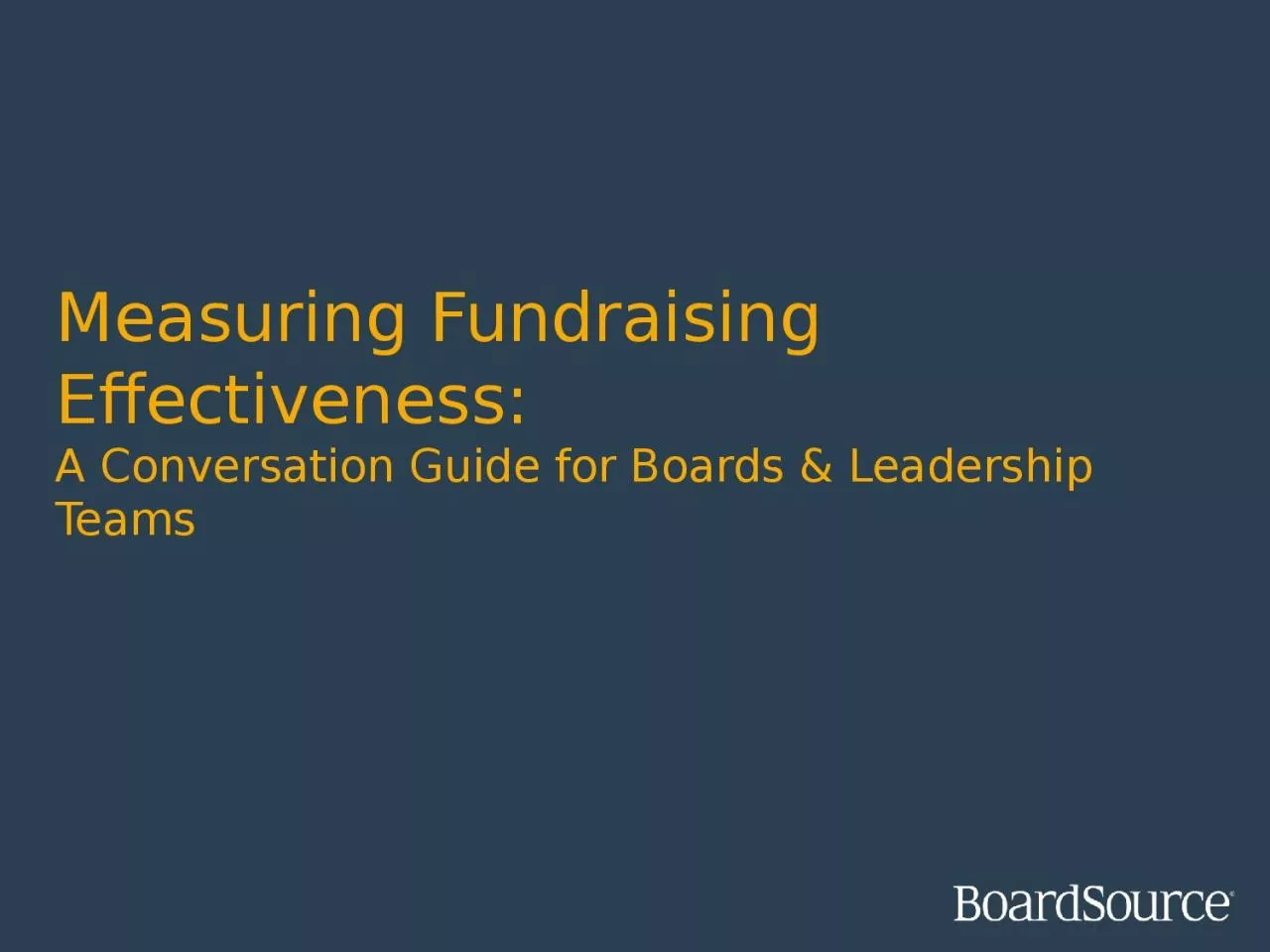

A Conversation Guide for Boards amp Leadership Teams The Boards Role in Fundraising Our Core Responsibilities That means tackling these big questions But the most common measure of fundraising effectiveness ID: 1020230
Download Presentation The PPT/PDF document "Measuring Fundraising Effectiveness:" is the property of its rightful owner. Permission is granted to download and print the materials on this web site for personal, non-commercial use only, and to display it on your personal computer provided you do not modify the materials and that you retain all copyright notices contained in the materials. By downloading content from our website, you accept the terms of this agreement.
1. Measuring Fundraising Effectiveness:A Conversation Guide for Boards & Leadership Teams
2. The Board’s Role in Fundraising: Our Core Responsibilities
3. That means tackling these big questions:
4. But the most common measure of fundraising effectiveness – the so-called “cost of fundraising” – will not answer these questions for us.All it tells us is how much money we spend to raise a dollar.
5. But the public doesn’t know what else to use.
6. We believe there’s a better way.A new framework for measuring fundraising effectiveness has been developed by leaders within the nonprofit sector who understand fundraising and what it takes for a nonprofit to succeed.
7. It’s rooted in the following principles:We believe in the work of nonprofit organizations and know that the most important measure of our effectiveness is the impact that we are having in our communities and our society as whole.We know that charitable support from donors and funders is what makes that impact possible, which means fundraising is absolutely mission critical.We believe that it’s reasonable to expect a nonprofit to care about efficiency and return on investment in its fundraising efforts, but that it is not the only – or even the most important – way of measuring fundraising effectiveness.
8. The Three Most Important Measures of Fundraising EffectivenessTotal Fundraising Net: Are we raising enough money to fund our mission now and in the future?Dependency Quotient:To what extent are we dependent on a small number of large-scale donations?Cost of Fundraising:How efficiently are we raising funds, and are our overall efforts achieving high return on investment?
9. Dependency Quotient as a Measure of Risk15%50%90%How much is too much?What percentage of our budget would be unfunded if we lost our top five donors?
10. Balancing Risk & Reward:There is an inverse relationship between the dependency quotient and cost of fundraising.or
11. The Goal
12. How are we doing?
13. Drilling Down: Lower Dependency Quotient/Higher Cost of FundraisingIf you have a lower dependency quotient and a higher cost of fundraising, you are likely investing heavily in fundraising programs that are building up diverse sources of funding, which means that you’re not particularly dependent on any particular donor, but your cost of fundraising is somewhat higher as a result. Questions to ask:Are we seeing long-term ROI from our broad-based donation programs, such as direct mail or telemarketing?Are we fully leveraging opportunities to encourage donors to engage more deeply with us through our major gifts and annual programs?Are we missing opportunities to go after large-scale gifts from foundations or corporations?
14. Drilling Down: Higher Dependency Quotient/Lower Cost of FundraisingIf you have a higher dependency quotient and a lower cost of fundraising, you are likely receiving big donations from a handful of donors, and may not have many other sources of funding.Questions to ask:How confident are we in the year-over-year reliability of our top five donors? Are they committed to us for the long-term, or is there a possibility that their support will end? Have we talked with them about that?If one or several of those sources went away, what would the impact be on our programs? Do we have a safety net that would enable us to continue to do our work?How many donors are we cultivating that could be big donors in the future? Who are they, and how likely is their support?If there’s an unlikely future for us with current or future donors, what can we do now to build for greater resilience?
15. Drilling Down: Higher Dependency Quotient/Higher Cost of FundraisingIf you have a higher dependency quotient and a higher cost of fundraising, you are likely investing heavily in multiple fundraising strategies, but are still highly dependent on a few sources of funding, which is a potentially troubling combination.Questions to ask:Are we strategically investing in fundraising programs that aren’t high ROI yet, but that we anticipate being high ROI in the future?Are we investing enough in mid-range donor strategies that work to convert lower-dollar donors into higher-dollar donors?Are we relying heavily on expensive fundraising strategies that aren’t performing and aren’t likely to perform better in the future?
16. Drilling Down: Lower Dependency Quotient/Lower Cost of FundraisingIf you have a lower dependency quotient and a lower cost of fundraising, you’re likely doing something right, as this is very difficult to achieve! Nonetheless, it’s wise to ask questions that could reveal opportunities or vulnerabilities.Questions to ask:Is our program on a growth trajectory that will continue to support our organization’s needs?Are we investing enough in donor engagement and stewardship? Do we have strong renewal rates to prove it?Are our staffing levels sustainable and helping us avoid burnout?